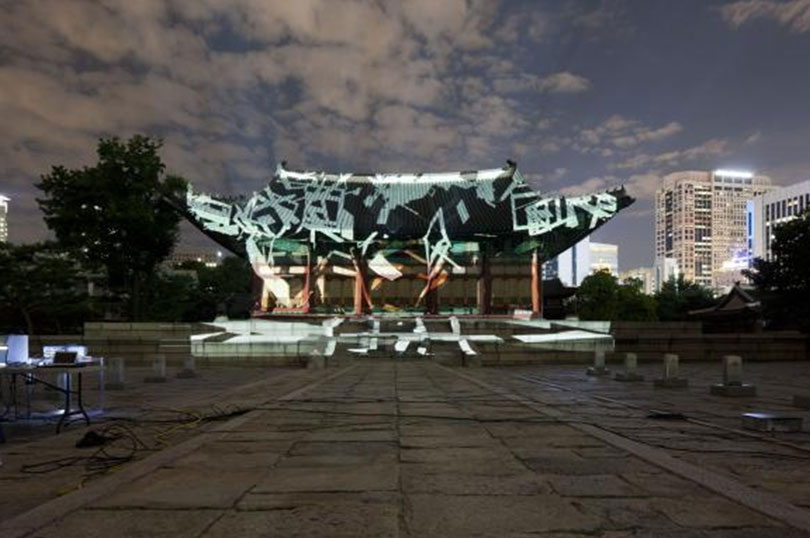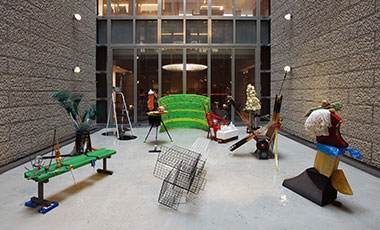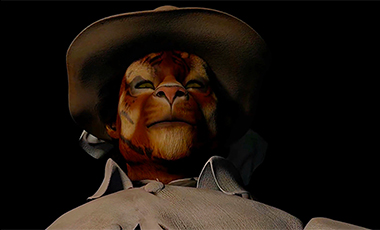In the NovemberArt Talk, we review the 《Deoksugung Project》 (2012.9.19.~12.2, Deoksugung Palace), which has brought a nation-wide sensation through the encounter between Deoksugung and Korean contemporary art. At every place in Deoksugung which has various time layers as a historical site, this art project exhibits various works of Korean contemporary art by diverse creators from diverse fields such as artists, dancers, and so on. As far as the Art Talk is a comer that proposes diverse points of view through cross-criticisms by diverse experts from various fields, we reviewed this project and art works this time with peculiar aspects of diverse critics of various fields, including the curator of the project.
《Deoksugung Project》: To get over the Sadness to Pieces
From Deoksungung Project to Gyungwoongung Project
First of all, I give a warm and cheerful clap to the 《Deoksugung Project》 held in a palace. It was a meaningful project to evoke a special emotion toward the royal family's authority and historical legacy by attempting of installing contemporary art in the symbolic place in an "old palace." Moreover, viewers could make an unusual outing in the Deoksugung only with 1,000 won for admission. It is reason for me to write a review at the point of the exhibition's closing time that I hope a consecutive series of the project on the basis of its success this time.
 Lyu Jaeha_Junghwajeon, Time_National Museum of Contemporary Art Korea Commission, 2012
Lyu Jaeha_Junghwajeon, Time_National Museum of Contemporary Art Korea Commission, 2012
While walking in the palace under the red leaves on maple trees with a transparent sky of the fall for a background, I sensed that unmanageable feelings flooded in my mind. It still gives me a feeling of a burden. The works installed in the dispersed buildings brought me fragmented feelings of sadness. Did the 《Deoksugung Project》 trouble viewers' mind as if contemporary art often stirs our senses of discomfort? Being a beautiful palace of Chosun Dynasty, the Deoksugung is a place of which the spirits weigh heavily on my shoulders. Why is it? A scene flashes before my eyes: a scene from the collection of photographs of Emperor Gojong's funeral with the Daehanmun Gate of the Deoksugung in 1919. Is it due to the heavy weight of the modern history I feel as a Korean?
While the title is the 《Deoksugung Project》 this time, I would like to suggest ‘Gyeongwoongung Project' next time at the same place. Someone might ask back if the title of the project would matter, but I would answer that the latter might be a significant keyword in delivering its viewers the direction of the whole project. It would be far better if more questions will be The Deoksugung's history is, ironically, well recorded in 『The History of the Deoksugung』 (1938) written by Oda Shogo who was a professor of the Gyeongsung Imperial University during the Japanese colonial era. According to the book, the name Deoksugung began to be used to wish King Gojong's longevity when he abdicated from the crown in 1907. When recollecting the historical fact that the King Gojong began to have called as ‘Deoksugung Itaewang' after 1910, we can find that a ‘sad memory' of failed modernization is perhaps postulated in the name of ‘Deoksugung.' Even the feeling beyond my capacity, the sadness, could be the ‘heritage of history' as the curator explained. As if corresponding with this intention, the artworks exhibited in the 《Deoksugung Project》 2011 kept the sadness as their underlying tone. The works placed in the dispersed buildings scatter our feelings in fragments. I hope to free myself from this sort of feeling, a feeling of scattered sorrows like the tears swept in each building, or a feeling that cannot become familiar permanently.
What about calling the next project the ‘Gyeongwoongung Project?' It is to interpret the same place in a different way. King Gojong announced of the Daehan Empire in the February of 1897. The Deoksugung was called as Gyungwoongung at that time. It was the very place where the Daehan Empire dauntlessly pursued its dream. It was also the place where the King Gojong propelled the dream of modernization by combining the cultures of East and West. Seokjojeon was built by a British architect invited by the King, for example.
Let's add more bold courage in planning the project next time. I hope that the process of diverse interpretations of the same place and sharing of them would be reflected in the art works among artists, architects, writers, and art historians. If then, wouldn't some artists produce strong works with an ‘unyielding will' rather than ‘the sadness of a loss?' Or a boldness to blow out temporary frustration of the modernization at once? For, we overcame the tortuous history of modern era in spite of vicissitudes and finally achieved today's Korea. And the Deoksugung is the place that has witnessed the process explicitly.
Couldn't the artists interpret ‘modern era' more dramatically with the King Gojong's ambition and frustration that connect Chosun with the present day rather than perceive it as a sadness in the 《Deoksugung Project》? By stepping further, would artists blame the royal family for losing our country, or sympathize the pain due to the fall of the dynasty? And they also could throw a reflective question to viewers if the sorrow of losing country is only the key feelings for the Deoksugung.
In addition, there exists an interpretation on a new code, ‘West' in the late Chosun period, at every place inside of the Gyungwoongung (Deoksugung). It might be more innovative if the artists' expressions would cover and reinterpret the conflicting interests among the Western powers that the Chosun Dynasty confronted during the modern period.
Lastly, there remains one tiny thing I desire. It was an apparatus as nice as can be to take off shoes while entering the palatial buildings in order to bring viewers inner part of the art works. Nevertheless, the space of Dukhyeongju (Prince Dukhye) at Seogeodang represented by Kim Young Seok chilled down my spine and made my blood run cold. May I say it was horrifying? Would we be allowed to enter and look daringly into the young princess' private room? Is it merely a rebirth as a beautiful female room? I could not help but sense unexpected, complex feelings of lost manners and missing of the royal family's authority. I do not want to peep into the princess' room like this way if I happen to revisit the same place.
I expect that artists' various interpretations with the recondite tension between the Chosun Dynasty's royal authority and anti-authority, and with the recompositions of tradition beyond the sadness would be expressed in the continuous openings of the 《Deoksugung Project》 annually in the future.
Deoksugung Project viewed by 6 people
《Deoksugung Project》: Reconciliation between Crash of Time and Scenography _ Kim Namsoo(Choreography Critic)
The Calling of Memory _ Jung Hyun(Art Critic, Independent Curator)
The inside of time in the eternal rest _ Gu Na-yeon(Art Critic)
I want to go further back in time _ Kim, So-yeon(Theater critic)
《Deoksugung Project》: Contemporary Interpretation on Legacy _ Kim Inhye(Curator, National Museum of Contemporary Art Korea )

Sun Seunghye / Professor, Sungkyunkwan University
Sun is now a HK professor (Aesthetics and Art History) at the Academy of East Asian Studies of Sungkyunkwan University. As a consulting curator of Korea-Japan art for Cleveland Museum in the United States of America, the author has currently promoted the opening of Korean Room and Japanese Room in 2013, and a special exhibition Re-creation of Tradition: Japanese Modern Art. Her career includes the positions such as the curator of Korean & Japanese Art at the Cleveland Museum in the United States (2010-2011), the Foreign Researcher of Tokyo National Museum in Japan (2007), and a curator of the National Museum of Korea (2002-2009). Sun earned her Bachelor and Master degrees at the Department of Aesthetics, Seoul National University in Korea, before her PhD degree at the Department of Art History, Tokyo University in Japan. The author organized such special exhibitions as The Lure of Painted Poetry in Korean and Japanese Art(2010), The Eminent of Gongju(2009), Japanese Modern Paintings(2008), Retro Style of Japanese Art(2007), The Color of East Asian Art: Multi-colored Print of Paul Jacoulet (2006), and so on.


